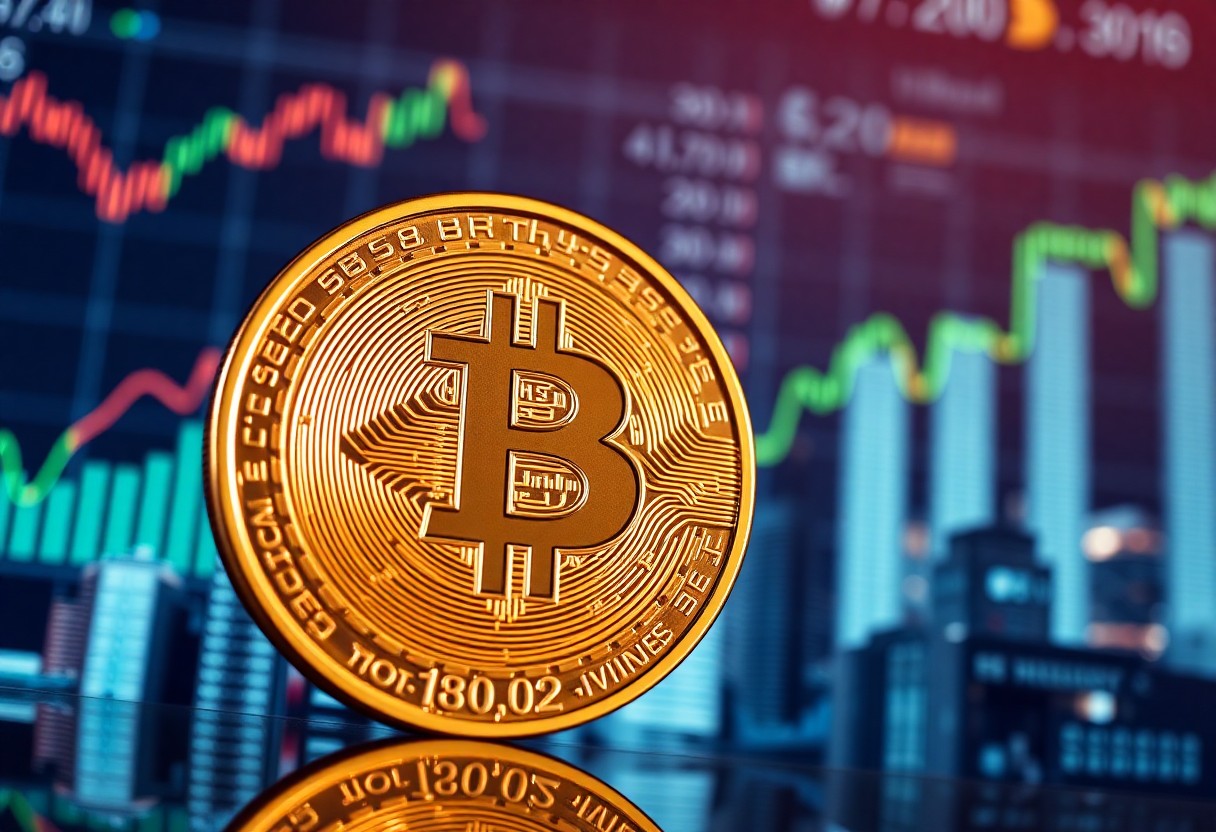Now Reading: Bitcoin Surpasses $60,000 – Analyzing the Factors Behind the Surge
-
01
Bitcoin Surpasses $60,000 – Analyzing the Factors Behind the Surge
Bitcoin Surpasses $60,000 – Analyzing the Factors Behind the Surge

It’s a significant moment in the cryptocurrency landscape as Bitcoin has exceeded $60,000, a milestone that can influence your investment strategy. This rapid increase can be attributed to various factors that are shaping the market today, including institutional investments, regulatory developments, and evolving public perception. In this post, you’ll gain insights into these elements that may affect your financial decisions. For a deeper look, check out this article on Bitcoin Hits US$60K: All-Time High Ahead?.
Key Takeaways:
- The surge in Bitcoin’s price to over $60,000 is significantly influenced by increased institutional investment, indicating a growing acceptance of cryptocurrencies within the financial mainstream.
- Macroeconomic factors, such as inflation concerns and a weakening dollar, have driven investors to seek out Bitcoin as a hedge against economic instability.
- Technological advancements and enhancements in blockchain infrastructure have improved transaction efficiency and security, further boosting confidence among investors and traders.
Market Dynamics Driving Bitcoin’s Surge
Amidst the backdrop of increasing mainstream acceptance, various market dynamics are propelling Bitcoin’s impressive rise above the $60,000 mark. Factors like heightened institutional investments, coupled with the influence of retail investors, play a pivotal role in shaping the price movements. The interplay between supply and demand, regulatory developments, and macroeconomic trends also contribute significantly to this surge, creating a unique landscape for both seasoned investors and newcomers alike.
Institutional Investments and Adoption
About the pivotal role of institutional investments, major financial players, hedge funds, and corporations have begun to recognize Bitcoin as a legitimate asset class. Their growing willingness to allocate substantial resources towards Bitcoin signifies a shift in the perception of digital currencies. This adoption not only enhances market liquidity but also instills confidence among retail investors, propelling Bitcoin’s upward trajectory.
Retail Investor FOMO and Speculation
Beside institutional support, the phenomenon of retail investor FOMO (fear of missing out) has surged dramatically, further inflating Bitcoin’s price. As stories of significant profits circulate, you find yourself lured into speculation, driving demand to unprecedented levels.
Driving this surge is the intense speculation from retail investors who inadvertently fuel Bitcoin’s price volatility. Many of you may feel the pull to invest, amid rampant stories of individuals earning life-changing profits. While this can create significant short-term gains, investing under such conditions introduces substantial risks. The psychological influence of FOMO can lead to hasty investments, with many entering the market at precarious price points, potentially leading to significant losses if the bubble bursts. Being informed and staying abreast of market trends will empower you to navigate these dynamics wisely.
Macroeconomic Influences on Bitcoin’s Price
Some of the main factors driving Bitcoin’s price surge relate to broader macroeconomic conditions. As traditional markets react to changes in economic policies and global events, Bitcoin has emerged as an alternative investment vehicle for many. Understanding how these macroeconomic influences interact with Bitcoin’s value can provide you with deeper insights into today’s financial landscape.
Inflation and Monetary Policies
The impact of persistent inflation and loose monetary policies has been significant on Bitcoin’s ascent. Central banks around the world have adopted aggressive quantitative easing measures, leading to a decline in fiat currency’s purchasing power. Consequently, you may find Bitcoin appealing as a hedge against inflation, further propelling its price in a favorable environment.
U.S. Interest Rates and Global Economic Trends
On the other hand, U.S. interest rates play a vital role in shaping the global economic landscape that influences Bitcoin’s performance. When interest rates are low, traditional savings and investment vehicles often yield less, making cryptocurrency investments more attractive.
But as the Federal Reserve adjusts interest rates in response to economic conditions, the landscape for Bitcoin can shift dramatically. A hike in interest rates may lead you to reassess your investment strategy, as higher yields on bonds and savings accounts could redirect funds away from riskier assets like Bitcoin. Furthermore, global economic trends such as geopolitical tensions and trade policies can create an environment of uncertainty, driving demand for cryptocurrencies as a store of value. Therefore, staying updated on these trends can help you make informed decisions in an ever-changing market.
Supply and Demand Mechanics
Not only is Bitcoin’s price influenced by trading activity, but its fundamental supply and demand mechanics play a vital role. As more individuals and institutions buy into Bitcoin, the demand increases while the supply remains limited, leading to upward price pressure. This delicate balance between buyers and sellers shapes the market dynamics, contributing significantly to Bitcoin’s recent surge beyond the $60,000 mark.
Bitcoin Halving and Scarcity Factor
After each Bitcoin halving event, the reward for mining new blocks is halved, effectively reducing the rate at which new bitcoins are generated. This scarcity factor tends to create a sense of urgency among investors, driving up demand due to the perception that fewer bitcoins will be available in the future. The anticipation and reality of increasing scarcity often trigger substantial price increases, contributing to Bitcoin’s impressive value trajectory.
Exchange Reserves and On-Chain Activity
Across various cryptocurrency exchanges, the behavior of exchange reserves can signal underlying market trends. When reserves are low, it often indicates that holders are removing their Bitcoin from exchanges, favoring long-term storage over selling. This trend typically suggests a bullish sentiment, driving up prices as on-chain activity increases. The dynamics between exchange outflows and the overall market can provide you insights into potential price movements.
Understanding the relationship between exchange reserves and on-chain activity is imperative for grasping Bitcoin’s market behavior. When you see significant deposits made to exchanges, it may indicate sellers are preparing to offload their assets, potentially leading to downward price pressure. Conversely, high outflows suggest that investors are opting to hold their assets, decreasing readily available supply and enabling price appreciation. Monitoring these metrics not only informs you about current market sentiment but also about potential future volatility, allowing you to make strategic investment decisions.
Regulatory and Legal Developments
All eyes have recently turned to Bitcoin Price History: What Was Bitcoin’s Highest Price?, as regulatory and legal changes significantly impact the cryptocurrency market. With governments across the globe developing frameworks for digital currencies, the surge in Bitcoin’s value often reflects increased institutional acceptance and better-defined rules. This clarity reassures investors, allowing the market to flourish under the right guidance.
Government Stances on Crypto
Developments in government stances on cryptocurrency have influenced Bitcoin’s growth trajectory immensely. Your investment confidence is often tied to how supportive or restrictive local regulations become. Countries adopting a favorable approach may foster a more robust crypto ecosystem, whereas restrictive measures could instigate market volatility.
Impact of ETF Approvals and Rejections
Beside government regulations, the impact of ETF approvals and rejections remains significant in the crypto landscape. The market tends to respond positively to ETF approvals, which generally signal increased institutional investment and trust in Bitcoin. Conversely, rejections can induce uncertainty, making you wary of the sustainability of Bitcoin’s price rise.
Stances on ETF approvals have been marked by both excitement and trepidation. A positive decision can lead to a surge in Bitcoin prices as larger investment firms gain access to the market, fostering wider adoption. On the flip side, ETF rejections often result in a sharp decline, creating feelings of apprehension among investors. Understanding these dynamics is imperative for navigating your investment decisions effectively.
Technological and Network Innovations
Many factors contribute to Bitcoin’s impressive price surge, including significant advancements in technology and the underlying network. Innovations like the Lightning Network and improvements in blockchain scalability have enhanced transaction speed and reduced fees. These developments have played a pivotal role in attracting a broader audience to Bitcoin, as seen in this article about Bitcoin surpasses $60,000 in record high as rally accelerates.
Lightning Network and Scaling Solutions
At the forefront of these innovations is the Lightning Network, which facilitates instant and low-cost transactions. This layer-2 solution enables users to make numerous transactions off-chain while recording only the final result on the blockchain, significantly increasing Bitcoin’s transaction throughput.
Security Enhancements and Developer Activity
Besides scalability, ongoing security enhancements and increased developer activity within the Bitcoin ecosystem contribute to its rise. You might notice that regular updates and community efforts focus on improving Bitcoin’s protocol and addressing vulnerabilities, ensuring its robustness against potential threats.
Security is paramount in the cryptocurrency landscape, and active developer engagement strengthens Bitcoin’s resilience. You should take note that with every update, new security measures are implemented, making the network less susceptible to attacks. This unwavering commitment to improving security protocols and enhancing usability serves as a testament to the community’s dedication, fostering user confidence and encouraging wider adoption.
Potential Risks and Market Corrections
For any investor in the cryptocurrency space, acknowledging the potential risks is vital. While Bitcoin’s recent surge past $60,000 is impressive, it can also lead to sudden market corrections. Factors such as investor sentiment, increased competition from altcoins, and geopolitical events can contribute to price volatility. Maintaining a balanced portfolio and staying informed about market trends can help you navigate these unpredictable waters.
Volatility and Market Manipulation Concerns
Any significant price movement in Bitcoin often raises concerns about market volatility and potential manipulation. Investors must be aware that sharp price swings can result from coordinated buying or selling by large holders, known as “whales.” This manipulation can affect your investment strategy and highlight the importance of thorough research and cautious trading.
Possible Regulatory Crackdowns
Among the pressing risks in the cryptocurrency landscape are potential regulatory crackdowns. As governments around the world scrutinize digital currencies, there is a possibility of new regulations being implemented that could impact your ability to trade or access Bitcoin. Market participants should pay close attention to government announcements, as regulatory uncertainty could lead to market instability and influence your investment decisions.
Market responses to regulatory changes can be quite severe. For instance, stricter regulations could limit the operational capacities of exchanges or impose heavy penalties on non-compliance, potentially leading to decreased liquidity and a drop in Bitcoin’s market value. Staying updated on government policies and engaging with reliable news sources can be beneficial for your investment strategy, ensuring you are prepared for any sudden shifts that regulatory actions may bring.
Final Words
Drawing together the various elements that contributed to Bitcoin’s surge past $60,000, it’s clear that a combination of increased institutional investment, growing mainstream acceptance, and macroeconomic factors like inflation fears have played significant roles. As you navigate this volatile market, understanding these dynamics can empower your investment decisions and strategies. Being informed about the trends and influences can help you position yourself advantageously in the evolving landscape of cryptocurrency.
FAQ
Q: What factors contributed to Bitcoin surpassing the $60,000 mark?
A: Several factors played a significant role in Bitcoin’s surge past $60,000. Firstly, increased institutional investment has been a major driving force, with companies like Tesla and Square investing large sums in Bitcoin, boosting confidence and adoption. Secondly, positive regulatory developments in various regions have created a more favorable environment for cryptocurrencies, encouraging investors to enter the market. Lastly, the growing interest in decentralized finance (DeFi) and non-fungible tokens (NFTs) has expanded the overall cryptocurrency market’s visibility, attracting more mainstream investors to Bitcoin.
Q: How has market sentiment influenced the rise in Bitcoin’s price?
A: Market sentiment has greatly influenced Bitcoin’s price, particularly during its climb past $60,000. Positive news, such as endorsements from high-profile investors and favorable regulatory news, has bolstered confidence among both retail and institutional investors. Additionally, the fear of missing out (FOMO) has driven many individuals to invest, further fueling demand. Social media platforms and online trading communities have also played a role, with discussions around Bitcoin often amplifying excitement and encouraging more trading activity.
Q: What implications does Bitcoin’s surge have for investors and the broader cryptocurrency market?
A: Bitcoin’s rise beyond $60,000 has important implications for investors and the broader cryptocurrency market. For investors, it signals a growing acceptance of cryptocurrencies as a legitimate asset class, potentially leading to more investment opportunities. However, the volatility associated with such price surges can pose risks, and investors should approach the market with caution. For the broader cryptocurrency market, Bitcoin’s performance often impacts the prices and interest in altcoins, potentially leading to increased market activity across various digital assets as investors seek to diversify their holdings.





















